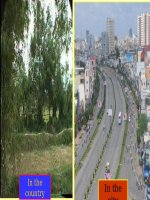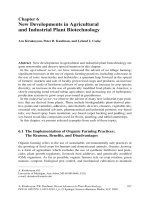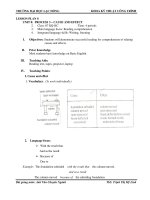8 wind and solar plant modeling print
Bạn đang xem bản rút gọn của tài liệu. Xem và tải ngay bản đầy đủ của tài liệu tại đây (2.87 MB, 75 trang )
Power Systems & Energy Course:
Wind and Solar Plant Modeling
Jason MacDowell
Alphabet Soup: Software
There are several software programs used by the
electric power industry for planning studies:
• “PSLF” -- by GE EA&SE (us: Energy Consulting, EC, PSEC, PSED,
EUSED, etc…)
•
•
•
“PSS/e” -- by PTI-Siemens (here in Schenectady)
“PowerFactory” –- by DigSilent (in Germany)
Other regional, specialty s/w:
France: “Eurostag”
Brazil: “ANDESA“
Think EXCEL
vs. LOTUS….
China: “BPSP”
Etc…
© 2016 General Electric International, Inc. All rights reserved. Not for distribution without permission.
2/
What is a ‘model’?
Utilities represent their entire system in a simulation model
(using software such as GE PSLF or Siemens PSS/E ®).
This model is a mathematical representation of all
components in the network, such as:
• Generation (Thermal, Renewables, etc…)
• Transmission (Lines, Transformers, FACTS, etc…)
• Loads
For illustration, we’ll compare a PSLF or PSS/E ®
‘model’ to an EXCEL spreadsheet ‘model’
© 2016 General Electric International, Inc. All rights reserved. Not for distribution without permission.
3/
EXCEL
To solve problems in EXCEL (or Lotus 123) , one needs:
1)
A license to the software, sold by Microsoft (or ?)
2)
A workbook file for the problem at hand
3)
A library of built-in functions (e.g. SQRT, NPV, etc..). Users can’t change the function, but must
give it input data to produce output.
4)
Possibly some special MACROs, written to provide non-standard functions (e.g. tax depreciation
on capital equipment in Elbonia) User’s need the structure (code) of the macro AND input data.
5)
Data to drive calculations, functions and MACROs
PSLF and PSS/E ®
To solve problems in PSLF and PSS/E ®, one needs:
1)
A license to the software, sold by GE or PTI-Siemens
2)
A data set for the problem at hand (this is the grid “model”. )
3)
A library of built-in functions (called “standard library models”), e.g. GENROU (for synchronous
generators), IEEEST1 (for one standard type of excitation system), GGOV1 (simple governor for gas
turbines)…. There may be thousands of these models in the grid model.
4)
Possibly some special MACROs, written to provide non-standard functions (called “user-written models”),
e.g. HVDC, special relays, and some wind turbine generators…)
5)
Data to drive calculations, standard models, user-written models and ‘events’. Without data, the
functions and MACROs don’t work. Thus, the data is part of the ‘model’.
© 2016 General Electric International, Inc. All rights reserved. Not for distribution without permission.
4/
WTG Model Development
Considerations
> Time-frame of Interest
> Adequate Detail
> Consistency with Similar Models
GE WTG Models
> Steady-state
> Dynamic
© 2016 General Electric International, Inc. All rights reserved. Not for distribution without permission.
5/
Time-Scale of Dynamic Performance
EMTP Analysis
Small Signal Analysis
Fundamental Frequency Analysis
High Bandwidth, Non-Linear Systems
Control Design
Switching Transients
Harmonics &
Filter Design
Electro-Mechanical
Interactions
Transient Stability
Oscillatory Stability
Long-term Dynamic Stability
10 -6
10 -5
10 -4
.001
.01
.1
1 cycle
1
10
100
1000
1 minute
10 4
1 hour
TIME (Seconds)
© 2016 General Electric International, Inc. All rights reserved. Not for distribution without permission.
6/
Wind Farm Steady-State Model
•
Example Layout
•
Equivalent Model
>
Generator
-
Power Factor Range
-
Voltage Regulation
>
Transformer
>
Collector System
© 2016 General Electric International, Inc. All rights reserved. Not for distribution without permission.
7/
Modeling a Wind Power Plant?
•
38 WTGs
•
8 Feeders
•
57 MW
•
Substation
>
34.5kV Collector
>
230kV Circuits to
POI
© 2016 General Electric International, Inc. All rights reserved. Not for distribution without permission.
8/
Equivalent Model for System Level Studies
Point of
Interconnection
(POI) Bus
High Side Bus
(collector, e.g.
34.5kV)
P gen
Vreg bus
Substation
Transformer
For most systems of N machines,
model an equivalent transformer
and machine as N times one.
Represent entire farm capability
in power factor range, voltage
regulation, etc.
Q gen
Vterm
Substation transformers usually
have FOA rating roughly equal to
total MVA of WTGs.
© 2016 General Electric International, Inc. All rights reserved. Not for distribution without permission.
9/
Equivalent Model for Plant Application Studies
Project Substation
Point of
Interconnection
(POI) Bus
High Side Bus
(collector, e.g.
34.5kV)
For most systems of N machines,
model an equivalent transformer
and machine as N times one
Terminal Bus
P gen
Collector
Equivalent
Impedance
Vreg bus
Substation
Transformer
Substation transformers usually
have FOA rating roughly equal to
total MVA of WTGs. Substation
collector bus may have additional
shunt reactive compensation to
augment machine var capability
Unit
Transformer
Q gen
Vterm
Unit Transformers are normally
1.75 MVA, 5.8% leakage reactance
delta-wye connected padmounts
The collector system may cover
several miles, and have different topologies.
Provide an approximate equivalent R & X.
Include charging, particularly for cable collector systems.
© 2016 General Electric International, Inc. All rights reserved. Not for distribution without permission.
10 /
Volt/Var Control for Application Studies
Project Substation
Point of
Interconnection
(POI) Bus
High Side Bus
(collector, e.g.
34.5kV)
Terminal Bus
P gen
Collector
Equivalent
Impedance
Vreg bus
Substation
Transformer
The supervisory control will
instruct individual machines
to adjust their reactive
power output in order to
regulate system voltage;
normally at the point-ofinterconnection
Unit
Transformer
Q gen
Vterm
GE 1.5 MW machines offered in a range of steady-state
reactive power capabilities at their terminals.
A common range:
• 0.90 pf overexcited (delivering 730 kVARs to the system)
• 0.90 pf underexcited (drawing 730 kVARs from system)
Frequently provides +/- 0.95 pf at POI
© 2016 General Electric International, Inc. All rights reserved. Not for distribution without permission.
11 /
Typical Dynamic Model Development
– Appropriate for time-frame of phenomena
– Adequate detail
– Consistent with other models
© 2016 General Electric International, Inc. All rights reserved. Not for distribution without permission.
12 /
Excitation System Structure
Voltage
Sensing
– Modeling depends on nature
and time scale of study
– Transient Stability
Manual
Voltage
Regulator
Automatic
Voltage
Regulator
Excitation
Power
Source
Tachometer
TurbineGenerator
De-excitation
– AVR
Protective
Relays
– Excitation power source
Field Current
Limiter
– V sensing & compensation
Overexcitation
Limiter (OEL)
– Oscillatory Stability
– add PSS
– Long-term Dynamics
– add OEL, UEL, FCL
Power
Transformer
Terminal
Voltage
& Current
Voltage Sensing
and Compensation
Underexcitation
Limiter (UEL)
Generator Flux
(Volts/Hertz)
Limiter
Power
System
Stabilizer
Power, Frequency
or
Other Signals
© 2016 General Electric International, Inc. All rights reserved. Not for distribution without permission.
Rotor Speed
13 /
Excitation System Model
V ref
VT
AVR
Vref
VT
+
–
–
VR
VRmax
Ka
1+sTa +
VRmin
E fd
Exciter
–
Saturation
S e(E fd)*E fd
1
Ke+sTe
E fd
sKf
1+sTf
© 2016 General Electric International, Inc. All rights reserved. Not for distribution without permission.
14 /
WTG and Solar Dynamic Models
• WTG Overview
• Model Structure
Generator/Converter with Voltage Protection
Electrical Control
Turbine and Turbine Control (for WTG)
Wind Power (or Irradiance)
© 2016 General Electric International, Inc. All rights reserved. Not for distribution without permission.
15 /
GE WTG Dynamic Models
Doubly Fed Asynchronous (DFG) WTG
P
net
P
net
Q net
Q net
3 AC Windings
fnet
P stator
frotor
P rotor
Collector
System
(e.g.
34.5kV
bus)
Collector
System
P rotor
F rotor
P conv
F network
Full Converter (FC) WTG
Wind Turbine
Wind Turbine
Wound --Rotor
Wound
Rotor
Induction Generator
Induction
Generator
Converter
Converter
Converter
P stator
AC Winding
Wind Turbine
Q
Pnet= Pstator
Q net
f stator
stator
fnet
f stator
net
P stator
frotor
DC Winding
P rotor
Collector System
(e.g. 34.5kV bus)
E fd
… and Solar PV
© 2016 General Electric International, Inc. All rights reserved. Not for distribution without permission.
16 /
PSLF WTG Dynamic Model Structure
V reg bus
V term
Trip Signal
Ip (P)
Command
P elec
Electrical
Control
Model
Generator/
Converter
Model
Qelec
P gen , Q gen
E" or I Q (Q)
Command
Power
Order
Wind Profile
Model
(User-written)
Wind
Speed
P dbr
P elec
Turbine &
Turbine Control
Model
F term
© 2016 General Electric International, Inc. All rights reserved. Not for distribution without permission.
17 /
DFG Generator/Converter
• Generator flux dynamics neglected
• Rotor inertia dynamics included in turbine model
• Injects P & Q currents based on Electrical Control command
Eq"cmd
1
1+ 0.02s
(efd)
From
exwtge
-1
High Voltage
X"
Reactive Current
s0
Management
LVPL & rrpwr
IPcmd
Low Voltage
Active Current
IPlv
1
1+ 0.02s
(ladifd)
From
exwtge
Isorc
Management
s1
LVPL
Vterm
1.11
LVPL
Low Voltage
Power Limit
V
V
zerox
(0.50)
brkpt
(0.90)
1
1+ 0.02s
jX"
s2
Fast regulator and PLL action captured by
current management function. Also limits
terminal voltage to 120%.
© 2016 General Electric International, Inc. All rights reserved. Not for distribution without permission.
Low Voltage Power Logic
18 /
DFG Generator Protection
Recommended
PSLF and PSS/e LVRT II Setpoints
Low Voltage
Ride Through
vs. GE LVRT II & HVRT
Specs
Voltage at Point of Interconnection
(Percent)
140
120
100
PSLF LVRT II
80
60
40
GE LVRT II
20
0
-1.0
0.0
1.0
2.0
3.0
4.0
5.0
6.0
Time (seconds)
© 2016 General Electric International, Inc. All rights reserved. Not for distribution without permission.
19 /
DFG Generator Protection
Recommended
PSLF and PSS/e ZVRT Setpoints
Zero Voltage
Ride Through
vs. GE ZVRT(Nov 2008) &
HVRT Specs
Voltage at Point of Interconnection
(Percent)
140
120
100
80
PSLF
60
40
GE ZVRT
20
0
-1.0
0.0
200 ms
1.0
2.0
3.0
4.0
5.0
6.0
Time (seconds)
© 2016 General Electric International, Inc. All rights reserved. Not for distribution without permission.
20 /
DFG Generator Protection
• Over and under-voltage settings vary by project
• Low voltage trip data may be critical to performance so confirm with
manufacturer
ZVRT
LVRT
V (%)
DV (pu)
Time (sec)
V (%)
DV (pu)
Time (sec)
75
-0.25
1.9
75
-0.25
1.7
50
-0.50
1.2
50
-0.50
1.1
30
-0.70
0.7
30
-0.70
0.7
15
-0.85
0.2
15
-0.85
0.02
111
0.11
1.0
111
0.11
1.0
115
0.15
0.1
115
0.15
0.1
130
0.30
0.02
130
0.30
0.02
© 2016 General Electric International, Inc. All rights reserved. Not for distribution without permission.
21 /
DFG Electrical Control
Plant-Level Controller
Vrfq
WTG Controller
WindCONTROL
Emulator
Vreg
Qord
Option for user
written model
Open
Loop
Control
Logic
Qcmd
Eq"cmd
Qref
PFAref
Pelec
Power
Factor
Regulator
Electrical
Control
To Generator
Model
Reactive Power Control
Qgen
From
Wind Turbine
Model
IPcmd
Vterm
Pord
© 2016 General Electric International, Inc. All rights reserved. Not for distribution without permission.
22 /
DFG Reactive Power Control
WindCONTROL
Emulator
Vreg
Plant Voltage Control
Vrfq
(vref)
Vermx
+
1
1+ sTr
-
s3
+
s4
1/fN
-
Qmax
Kiv/s
+
Kpv
1+ sTv
Vermn
Vqd
Qwv
Qmin
1
1+ sTc
Qord
s5
s2
From Q Droop
Function
If yes, freeze
2 integrators
< Vfrz?
Power Factor Controller
PFAref
Pelec
Qref
tan
(vref)
1
1+ sTpwr
(vref)
x
s6
Qord
Qord from
separate
model
From
User Model
0
(vref)
1
pfaflg
0
1
varflg
-1
Qmax
Open
Loop
Control
Qcmd
Qmin
© 2016 General Electric International, Inc. All rights reserved. Not for distribution without permission.
23 /
DFG Q Droop Function
Improves coordination between multiple controllers
Q Input
1
1+ sTlpqd
Kqd
Vqd
s7
© 2016 General Electric International, Inc. All rights reserved. Not for distribution without permission.
24 /
DFG Electrical Control
Qgen
Vterm
Vmax
Qcmd
+
XIQmax
Vref
KQi / s
Eq"cmd
KVi / s
+
+
s0
Vmin
s1
XIQmin
(efd)
To Generator
Model
Auxiliary
Test Signal
( model[@index].sigval[0] )
Pord
(vsig)
From
Wind Turbine
Model
.
.
IPmax
IPcmd
(ladifd)
Vterm
© 2016 General Electric International, Inc. All rights reserved. Not for distribution without permission.
25 /









